An online project under the direction of the CAPE ANN MUSEUM
inv. 276
At the Fishing Grounds
1851 Oil 17 1/4 x 26 1/4 in. (43.8 x 66.7 cm) Signed and dated lower right: F.H. Lane / 1851
|
Explore catalog entries by keywords view all keywords »
Historical Materials
Below is historical information related to the Lane work above. To see complete information on a subject on the Historical Materials page, click on the subject name (in bold and underlined).
Schooners in Lane’s time were, with few exceptions, two-masted vessels carrying a fore-and-aft rig having one or two jibs, a fore staysail, gaff-rigged fore- and main sails, and often fore- and main topsails. One variant was the topsail schooner, which set a square topsail on the fore topmast. The hulls of both types were basically similar, their rigs having been chosen for sailing close to the wind. This was an advantage in the coastal trade, where entering confined ports required sailing into the wind and frequent tacking. The square topsail proved useful on longer coastwise voyages, the topsail providing a steadier motion in offshore swells, reducing wear and tear on canvas from the slatting of the fore-and-aft sails. (1)
Schooners of the types portrayed by Lane varied in size from 70 to 100 feet on deck. Their weight was never determined, and the term “tonnage” was a figure derived from a formula which assigned an approximation of hull volume for purposes of imposing duties (port taxes) oncargoes and other official levies. (2)
Crews of smaller schooners numbered three or four men. Larger schooners might carry four to six if a lengthy voyage was planned. The relative simplicity of the rig made sail handling much easier than on a square-rigged vessel. Schooner captains often owned shares in their vessels, but most schooners were majority-owned by land-based firms or by individuals who had the time and business connections to manage the tasks of acquiring and distributing the goods to be carried. (3)
Many schooners were informally “classified” by the nature of their work or the cargoes they carried, the terminology coined by their owners, agents, and crews—even sometimes by casual bystanders. In Lane’s lifetime, the following terms were commonly used for the schooner types he portrayed:
Fishing Schooners: While the port of Gloucester is synonymous with fishing and the schooner rig, Lane depicted only a few examples of fishing schooners in a Gloucester setting. Lane’s early years coincided with the preeminence of Gloucester’s foreign trade, which dominated the harbor while fishing was carried on from other Cape Ann communities under far less prosperous conditions than later. Only by the early 1850s was there a re-ascendency of the fishing industry in Gloucester Harbor, documented in a few of Lane’s paintings and lithographs. Depictions of fishing schooners at sea and at work are likewise few. Only A Smart Blow, c.1856 (inv. 9), showing cod fishing on Georges Bank (4), and At the Fishing Grounds, 1851 (inv. 276), showing mackerel jigging on Georges Bank, are known examples. (5)
– Erik Ronnberg
References:
1. Howard I. Chapelle, The History of American Sailing Ships (New York: W.W. Norton & Co., 1935), 258. While three-masted schooners were in use in Lane’s time, none have appeared in his surviving work; and Charles S. Morgan, “New England Coasting Schooners”, The American Neptune 23, no. 1 (DATE): 5–9, from an article which deals mostly with later and larger schooner types.
2. John Lyman, “Register Tonnage and its Measurement”, The American Neptune V, nos. 3–4 (DATE). American tonnage laws in force in Lane’s lifetime are discussed in no. 3, pp. 226–27 and no. 4, p. 322.
3. Ship Registers of the District of Gloucester, Massachusetts, 1789–1875 (Salem, MA: The Essex Institute, 1944). Vessels whose shipping or fishing voyages included visits to foreign ports were required to register with the Federal Customs agent at their home port. While the vessel’s trade or work was unrecorded, their owners and master were listed, in addition to registry dimensions and place where built. Records kept by the National Archives can be consulted for information on specific voyages and ports visited.
4. Howard I. Chapelle, The National Watercraft Collection (Washington, DC: Smithsonian Institution, 1960), 74–76.
5. Howard I. Chapelle, The American Fishing Schooners (New York: W.W. Norton & Co., 1973), 58–75, 76–101.
1852
Oil on canvas
28 x 48 1/2 in.
Cape Ann Museum, Gloucester, Mass., Deposited by the City of Gloucester, 1952. Given to the city by Mrs. Julian James in memory of her grandfather Sidney Mason, 1913 (DEP. 200)
Detail of fishing schooner.
Also filed under: Gloucester Harbor, Inner / Harbor Cove »
Stereograph card
Frank Rowell, Publisher
stereo image, "x " on card, "x"
Cape Ann Museum Library & Archive
View showing a sharpshooter fishing schooner, circa 1850. Note the stern davits for a yawl boat, which is being towed astern in this view.
Also filed under: Historic Photographs »
Model made for marine artist Thomas M. Hoyne
scale: 3/8" = 1'
Thomas M. Hoyne Collection, Mystic Seaport, Conn.
While this model was built to represent a typical Marblehead fishing schooner of the early nineteenth century, it has the basic characteristics of other banks fishing schooners of that region and period: a sharper bow below the waterline and a generally more sea-kindly hull form, a high quarter deck, and a yawl-boat on stern davits.
The simple schooner rig could be fitted with a fore topmast and square topsail for making winter trading voyages to the West Indies. The yawl boat was often put ashore and a "moses boat" shipped on the stern davits for bringing barrels of rum and molasses from a beach to the schooner.
– Erik Ronnberg
References:
Jeffrey Bolster, Black Jacks: African American Seafarers in the Age of Sail (Cambridge, MA: Harvard University Press, 1997).
Howard I. Chapelle, American Small Sailing Craft (New York: W.W. Norton & Co., 1951), 29–31.
Also filed under: Hand-lining » // Ship Models »
20 x 14 in.
Cape Ann Museum Library & Archive, Gloucester, Mass.
The image, as originally drafted, showed only spars and sail outlines with dimensions, and an approximate deck line. The hull is a complete overdrawing, in fine pencil lines with varied shading, all agreeing closely with Lane's drawing style and depiction of water. Fishing schooners very similar to this one can be seen in his painting /entry:240/.
– Erik Ronnberg
Newspaper
"Shipping Intelligence: Port of Gloucester"
"Fishermen . . . The T. [Tasso] was considerably injured by coming in contact with brig Deposite, at Salem . . ."
Also filed under: Newspaper / Journal Articles »
Newsprint
From bound volume owned by publisher Francis Procter
Collection of Fred and Stephanie Buck
"A Prize Race—We have heard it intimated that some of our fishermen intend trying the merits of their "crack" schooners this fall, after the fishing season is done. Why not! . . .Such a fleet under full press of sail, would be worth going many a mile to witness; then for the witchery of Lane's matchless pencil to fix the scene upon canvass. . ."
Also filed under: Fishing » // Newspaper / Journal Articles »
Also filed under: Cape Ann Advertiser Masthead »
Stereograph card
Procter Brothers, Publisher
Cape Ann Museum Library & Archive
"Gloucester Harbor from Rocky Neck, Looking Southwest. This gives a portion of the Harbor lying between Ten Pound Island and Eastern Point. At the time of taking this picture the wind was from the northeast, and a large fleet of fishing and other vessels were in the harbor. In the range of the picture about one hundred vessels were at anchor. In the small Cove in the foreground quite a number of dories are moored. Eastern Point appears on the left in the background."
Southeast Harbor was known for being a safe harbor.
Also filed under: Gloucester Harbor, Outer » // Historic Photographs » // Rocky Neck » // Small Craft – Wherries, and Dories »
Stereograph card
Cape Ann Museum Library & Archive
"Said schooner was captured about the first of September, 1871, by Capt. Torry, of the Dominion Cutter 'Sweepstakes,' for alleged violation of the Fishery Treaty. She was gallantly recaptured from the harbor of Guysboro, N.S., by Capt. Harvey Knowlton., Jr., (one of her owners,) assisted by six brave seamen, on Sunday night, Oct. 8th. The Dominion Government never asked for her return, and the United States Government very readily granted her a new set of papers."
Also filed under: Fishing » // Historic Photographs » // Waterfront, Gloucester »
Photograph
Cape Ann Museum Library & Archive
Also filed under: Gloucester Harbor, Inner / Harbor Cove » // Historic Photographs » // Waterfront, Gloucester »
Cape Ann Museum Library & Archive (2013.068)
Schooner fleet anchored in the inner harbor. Looking east from Rocky Neck, Duncan's Point wharves and Lane house (at far left), Sawyer School cupola on Friend Street.
Also filed under: Duncan's Point » // Gloucester Harbor, Inner / Harbor Cove » // Historic Photographs » // Waterfront, Gloucester »
See p. 254.
As Erik Ronnberg has noted, Lane's engraving follows closely the French publication, Jal's "Glossaire Nautique" of 1848.
Also filed under: Babson History of the Town of Gloucester »
Wood, cordage, acrylic paste, metal
~40 in. x 30 in.
Erik Ronnberg
Model shows mast of fishing vessel being unstepped.
Also filed under: Burnham Brothers Marine Railway » // Fishing »
Watercolor on paper
8 3/4 x 19 3/4 in.
Cape Ann Museum, Gloucester, Mass., Gift of Rev. and Mrs. A. A. Madsen, 1950
Accession # 1468
Fishing schooners in Gloucester's outer harbor, probably riding out bad weather.
Also filed under: Elwell, D. Jerome » // Gloucester Harbor, Outer »
Photograph
Cape Ann Museum Library & Archive
Ignatius Weber's windmill (now defunct) is shown.
Also filed under: Flake Yard » // Fort (The) and Fort Point » // Gloucester Harbor, Inner / Harbor Cove » // Historic Photographs » // Rogers's (George H.) wharves » // Waterfront, Gloucester » // Windmill »
Print from bound volume of Gloucester scenes sent to the Philadelphia Centennial Exhibition.
11 x 14 in.
Cape Ann Museum Library & Archives
Schooner "Grace L. Fears" at David A. Story Yard in Vincent's Cove.
Also filed under: Historic Photographs » // Shipbuilding / Repair » // Vincent's Cove »
The mackerel is a migratory fish, wintering off the Eastern Seaboard between December and March, then heading north, reaching southern New England in May. While some small schools split off to go to spawning grounds south of Cape Cod, the main group swarms over Georges Bank, a rich feeding area which provides the extra nourishment to proceed to regional spawning grounds to the north. This feeding pause provided fishermen their first opportunity of the season for a plentiful catch of high quality, as the schooners from many ports gathered en masse to fill their holds.
Lane's painting, At the Fishing Grounds, 1851 (inv. 276), long thought to depict cod fishing, actually portrays mackerel jigging on Georges Bank during the spring migration. The schooner in left foreground is under shortened sail, alternately jogging and luffing to position itself broadside to the school, so all the crew is able to fish without fouling lines. The horizon is almost completely covered with sails, indicating how intent the mackerel fleet was on harvesting this resource.
The fishing method depicted is called jigging, so-named for the hooks, called jigs, which have lead weights cast on their shanks, an invention attributed to a Sandy Bay fisherman, Abraham Lurvey, in the early nineteenth century. The newly-cast lead is shiny and thus attractive to the mackerel, which will take the hook, often if unbaited.
Mackerel often swim close to the surface, especially when feeding. If hungry, they will bite at chum (ground-up fish used as bait) and jigs in a feeding frenzy, keeping the fishermen very busy.
Mid-19th century
Base: 15" square Top: 15" x 19" Height: 36"
Gift of Capt. Ben Pine, 1946
Cape Ann Museum, Accession No. 1157
A hand-powered mill for grinding small bait fish (herring) into small bits called chum, which was kept in a chum box lashed to the side of the schooner amidships, on the starboard side, where the crew fished from the rail. As the mackerel swam under the schooner, chum would be tossed from the box with a large spoon in a process called tolling. If hungry, the mackerel would bite at the chum - and at fishing lines with mackerel jigs - in a feeding frenzy.
E.R.
Also filed under: Objects »
Wood, wicker, cordage
19 1/2 x 23 in.
Cape Ann Museum (2089-3 G/O EARR)
Used at wharfside for carrying fish and small fishing gear.
8 1/2 x 11 in.
Cape Ann Museum Library & Archive, Gloucester, Mass.
The mackerel gaff consisted of an iron rod 3-1/2 feet long with one or two barbs at the end, and socketed to a pole 10 to 12 feet in length. It was used to take mackerel when they were swimming around the schooner in great numbers but "not inclined to take the hook." By thrusting the gaff among the fish and rapidly withdrawing it, one or two mackerel could be caught at a time by a skilled user. This method fell out of use with the adoption of purse seining.
– Erik Ronnberg
Pencil and ink on paper
15 x 22 1/8 in.
Cape Ann Museum, Gloucester, Mass., Gift of Mr. Donald K. Usher, in memory of Mrs. Margaret Campbell Usher, 1984 (2401.19)
Also filed under: Beacons / Monuments / Spindles » // Gloucester Harbor, Outer »
8 1/2 x 11 in.
Cape Ann Museum Library & Archive, Gloucester, Mass.
Hand lines armed with jigs are dropped over the side, three to four lines per man. When a mackerel bites, the line is pulled up and the fish flipped or "jigged" over the rail. When the fish is on deck, a skillful fisherman can flip the hook out of its mouth without having to pick it up (the lead weight in the jig aids in this process). Small cleats on the rail hold the other lines secure during this process.
– Erik Ronnberg
8 1/2 x 11 in.
Cape Ann Museum Library & Archive, Gloucester, Mass.
Early mackerel jig molds were made by hand, using paper wrapped around the hook, a one-time for the mold. Soon thereafter, casting several hooks in a mold shaped from soapstone proved more efficient and productive. Molds made of lead were also used, allowing time for them to cool between castings. Iron molds led to commercial production of jigs by mid-nineteenth century.
– Erik Ronnberg
8 1/2 x 11 in.
Cape Ann Museum Library & Archive, Gloucester, Mass.
"Chum" (finely ground bait) is dipped from the "chum box" and scattered on the water to attract a school of mackerel. Fishermen lining the rail will catch the mackerel using hand lines with jigs.
– Erik Ronnberg
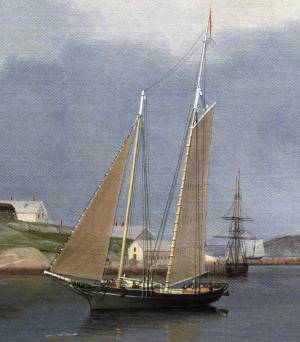
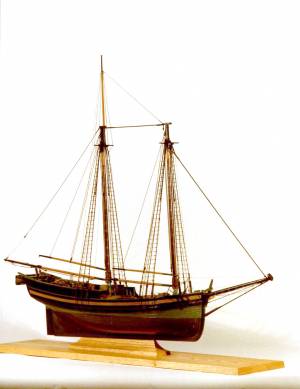


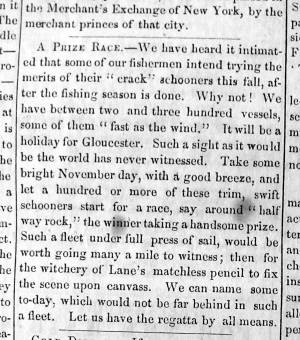
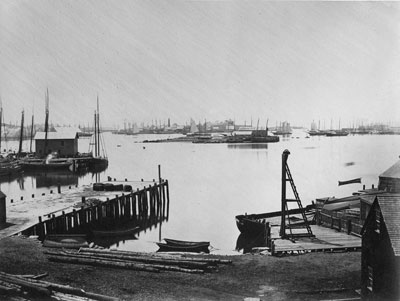

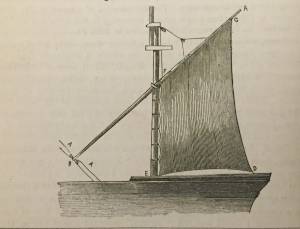
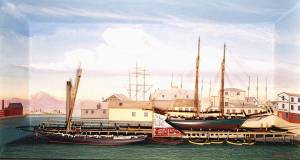

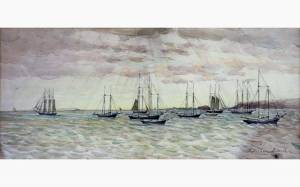


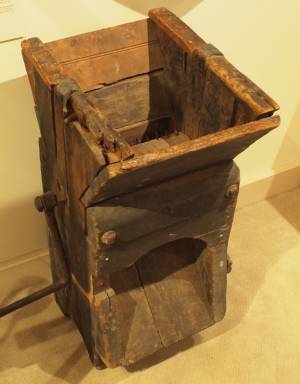
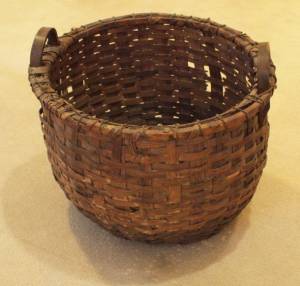
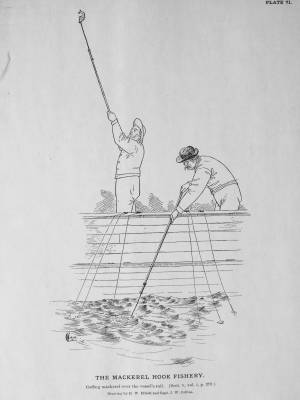

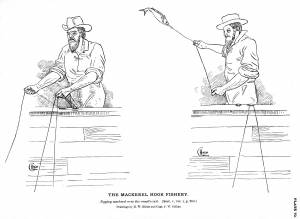
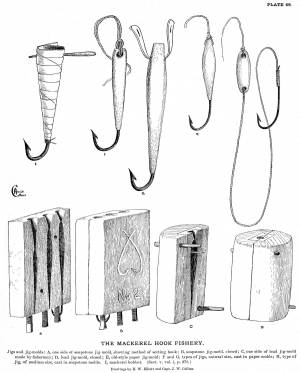
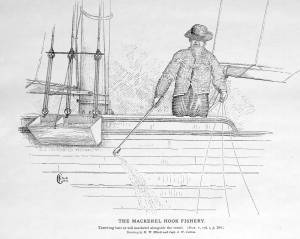
Commentary
This is one of a very few paintings by Lane that depict vessels at work on the fishing grounds. It was initially presumed to illustrate hand-lining for cod, but in fact shows schooners jigging for mackerel. Close inspection will show the fish to have mackerel stripes and the schooners are fitted with chum (bait) boxes on their sides from which the bait is scattered in a way called "tolling."
In spring, mackerel form large schools off the mid-Atlantic coast and migrate northward with small groups going off to their local spawning grounds as the main school heads northward. When Georges Bank is reached, the school pauses to take advantage of this rich feeding ground; it thereafter breaks up into regional schools which swim off to smaller grounds in Cape Cod Bay, the Gulf of Maine, Canadian coastal waters, and particularly the Gulf of St. Lawrence.
The significance of this scene is that it shows the last great gathering of mackerel schooners before the fleet breaks up to follow the smaller schools to their spawning grounds. The 1850s marked a peak period in this fishery when the catching of mackerel by hooks was to give way to capture using the purse seine and subsequent rises and falls in the fortunes of this fishery.
–Erik Ronnberg
[+] See More